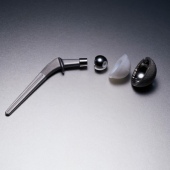 A service of the U.S. National Library of Medicine
A service of the U.S. National Library of Medicine  National Institutes of Health
National Institutes of Health

Hip Resurfacing More Likely to Fail Than Hip Replacement: Study

TUESDAY, Oct. 2 (HealthDay News) -- Hip resurfacing fails in many patients and should not be used in women, according to a large new study.
Often recommended to younger patients, hip resurfacing is similar to hip replacement except surgeons don't completely remove the femoral head (the rounded top section of the thighbone). A metal cap replaces the bone that has been removed. Hip resurfacing always has metal-on-metal bearings, while hip replacement uses different types of bearings, such as ceramic, metal or plastic.
Researchers looked at data from more than 434,000 hip operations conducted in England and Wales over eight years. Of these, nearly 32,000 were hip resurfacings. They found that the use of smaller femoral head sizes was linked to higher failure rates and, for the most part, resurfacing implants failed more quickly than other bearing surfaces.
The only exception was for men with a large femoral head, whose hip resurfacing success rates were similar to those who had total hip replacements. These patients accounted for only 23 percent of the men who had hip resurfacing.
Hip resurfacing success was particularly poor in women, with failure rates up to five times higher than other bearing surfaces.
"Resurfacing failure rates in women were unacceptably high," concluded researcher Ashley Blom, professor of orthopedic surgery at the University of Bristol, and colleagues. "In view of these findings, we recommend that resurfacing procedures are not undertaken in women."
The study was published online Oct. 1 in the journal The Lancet.
"Regulators and surgeons need to make proper recommendations for patients, such as not using resurfacing in women, and developing decision aids for patients to convey the benefits and harms of hip implants," Art Sedrakyan, a professor at Weill Cornell Medical College in New York City, said in a journal news release.
"It is also vital to prevent use of the marketing term 'young and active.' Few patients, even if elderly and inactive, will refuse a device that is intended for the young and active," said Sedrakyan, who wrote a commentary accompanying the study. "Communication with patients on all these issues should be more specific and evidence based."
SOURCE: The Lancet, news release, Oct. 1, 2012
- More Health News on:
- Hip Replacement
- Women's Health